Bonus material: Sales pipeline velocity calculator + B2B sales funnel template
In this guide, I’m going to show you a proven framework on how to create a B2B sales funnel from scratch or refine the existing sales process.
We used this process to grow Fullfunnel.io revenue by 50% this quarter compared to last year, shortening the average sales cycle by 20 days, and increasing the average deal value by 30%.
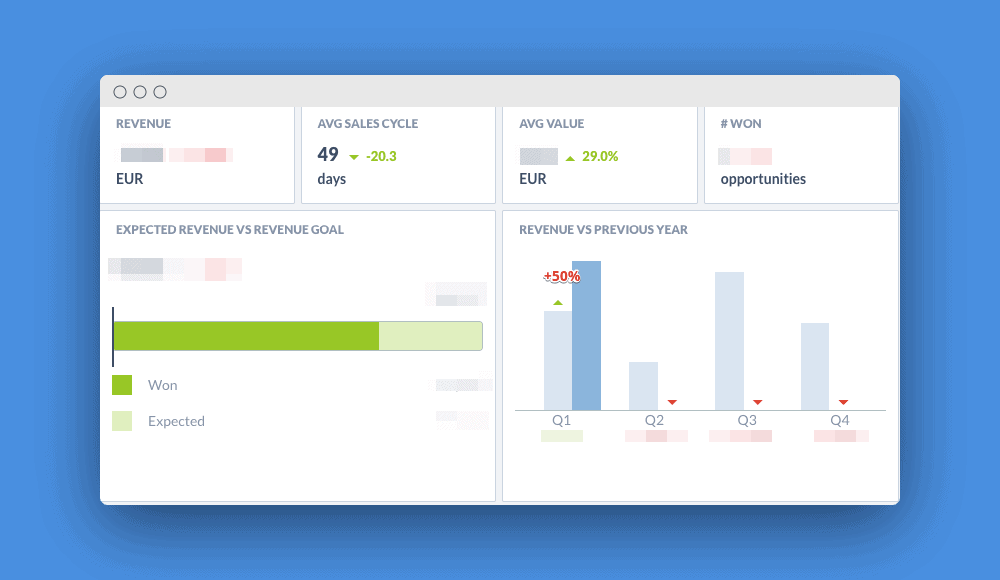
To achieve these results, I used a B2B sales funnel velocity calculator, a copy of which you can download above. So let’s move straight to the process.
Table of Contents
ToggleWhat is a sales funnel?
A sales funnel (or sales pipeline) is a visualization of your sales process and a set of steps your company makes from sales prospecting to closing deals.
The core purpose of the sales funnel is to divide the sales process into micro stages to figure out where exactly you are losing leads and what part of the sales process needs to be improved.
Regular analysis of the sales funnel helps B2B organizations to increase the close deal ratio, shorten the sales cycle, accelerate sales, and, as a result, hit revenue quota more often.
While it sounds simple and obvious, lots of B2B companies make the dangerous mistake I’m going to reveal in a moment.
The most dangerous B2B sales funnel mistake
In 1898 Elias St. Elmo Lewis invented the AIDA model to describe the simple 4-step B2B lead generation and sales process:
1. Awareness. Prospects become aware of your product via advertising or word-of-mouth (e.g., top-of-the-funnel marketing or demand generation campaigns)
2. Interest. Prospects see the product value and express interest in the product becoming leads (e.g., inbound inquiries or responses to the outreach)
3. Desire. Leads talk to sales to get answers to questions they have. Sales answer questions, show the benefits of the product to increase the urge to buy, and make a pitch. (e.g., discovery or demo calls)
4. Action – Leads buy the product and become customers. (e.g., proposals)
Simple?
You bet. But here is a caveat: simplifying a sales process was great a hundred years ago.
In a modern B2B world, you deal with multiple competitors, longer sales cycles, and not sales-ready leads (they aren’t seeking your product actively).
That’s why simplifying your lead generation, and sales processes with the AIDA model kill their efficiency.
What’s wrong with AIDA?
Here are several points the AIDA model misses.
1. AIDA combines lead generation and sales processes.
By default, AIDA means that you need to reach maximum prospects from your target addressable market and generate leads.
It makes sense for small, simple B2B businesses (e.g., cleaning services) that can rely solely on local SEO and AdWords.
For SMBs and enterprises, it’s almost impossible to run a simple AdWords campaign and generate a lead.
You deal with the buying committee, need to warm up and nurture them, set up a lead scoring program, and agree with sales on criteria when a lead should be transferred to sales.
Your sales team should prospect and talk to leads that were warmed up and fit the ideal customer profile. Otherwise, sales and marketing might be involved in an endless war of blaming each other who is guilty of missing the revenue quota.
It leads to the second problem.
2. AIDA focuses B2B companies only on prospecting sales-ready leads.
As I mentioned earlier, AIDA shows us only leads that replied to our direct campaign (e.g., retargeting or outreach). It leads to the dangerous mistake of starting to think that this is only the channel that works.
In a modern B2B world, you need to run multiple marketing and sales touches to generate a lead, so the last contact is just part of the nurturing program.
If you rely only on it, you can exclude other channels from your marketing programs that, as a result, will demolish the entire campaign.
Not all leads are sales-ready.
According to Hubspot, only 3% of any given B2B market is actively buying at the moment. When you cut the top and middle of the funnel marketing programs, you miss 97% of your target addressable market.
Another issue with focusing on sales-ready leads is that marketing tends to transfer leads to sales without qualification.
Hubspot says that 61% of B2B marketers send all leads directly to Sales; however, only 27% of those leads are qualified. You know the consequence already.
3. AIDA doesn’t show where exactly we missed the lead.
If your sales funnel consists of 4 simple stages: Reaching out, Booked A Call, Sent a proposal, Won/Lost, you’ll never understand where exactly you lost a deal and what you need to fix.
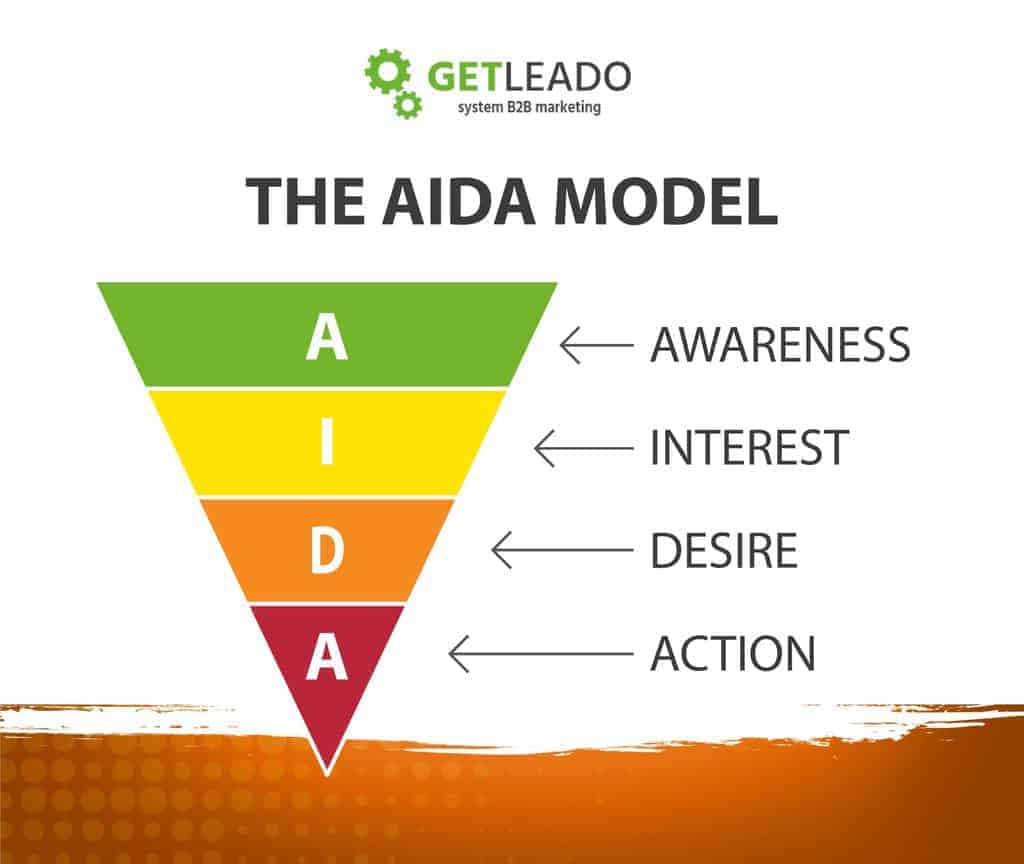
4. AIDA can’t replace the buyer journey.
Unfortunately, in B2B, we deal with a complicated buying process and long sales cycles. That’s why you need to understand the full funnel and address the entire customer journey.
The full funnel consists of demand generation and awareness programs, marketing qualification, lead nurturing, sales process, onboarding, customer satisfaction, and expansion processes.
To track the efficiency of the full funnel and all of these processes, I suggest creating three different funnels.

3 funnels every B2B organization needs
Here is a list of three core funnels you need to create and track separately.
1. Marketing funnel
The marketing funnel gives a clear overview of generated sales pipeline value and the number of prospects on different customer journey stages. It helps to predict how many sales-qualified leads can your sales team expects in the next month or quarter and forecast the revenue quota.
In the marketing funnel, we mark the deal as won when we generated a sales-qualified lead and transferred it to the sales team.
2. Sales funnel
The sales funnel shows the efficiency of the sales process, revenue generated, and sales team productivity. In a sales funnel, we track successfully closed and lost deals.
3. Client success funnel
I rarely see a client success funnel in B2B organizations cause they stop after sales. The reason why is that lots of B2B organizations have the “happy by default” mindset.
These companies rarely track customer satisfaction besides generic NPS. They simultaneously try to expand instead of identifying opportunities to scale business. They don’t run in-depth customer interviews, thinking that all customers are happy if they aren’t reaching out, which is, obviously, not true.
You need to have a structured process that onboards customers, tracks their satisfaction, prevents possible conflicts, generates case studies and referrals, and helps to identify opportunities to scale business with customers.
Why you should separate funnels
Here are 4 reasons why you should divide your funnels.
1. Accurate data
If you added all of the micro stages (we’ll talk about them later in this guide) to one funnel, it would be tough to analyze it. Another problem is that the funnel traditionally finishes at sales. How would you track the conversion in a client success funnel?
Some of the B2B companies prefer to simplify things, but when I ask:
- Do you know how many leads are in your lead nurturing program?
- How many in-depth interviews did you run recently to discover expansion opportunities?
- At what particular stages do you see the most significant drop?
I rarely get answers.
2. Different metrics
There is only one metric that unites B2B marketing, sales, and client success teams – revenue. All other metrics are different.
It is very similar to football, where a team has only one goal – winning the game. But can we say that the forwards are more important than the goalkeeper cause they scored goals?
No.
Midfielders should start attacks and supply forwards. In B2B, marketing should nurture and generate sales-qualified leads for sales.
Forwards should score goals, and B2B sales teams should close deals and hit the revenue quota.
The defense should break the rival attacks, prevent losing a goal, and start the attack. In B2B, the client success team should prevent churn, help customers get the maximum of the product or service, and find new business opportunities with them.
Otherwise, you’ll always be discussing who is better: Messi or Buffon, which leads us to the third reason.
3. Preventing marketing and sales war
Marketing should avoid at any price the “gimme more leads” mindset. The goal of the B2B marketing team is to generate sales-qualified leads for the sales team.
Sales-qualified leads mean that these leads meet the criteria, both the marketing and sales team agreed on. Otherwise, team war is inevitable.
4. Funnel accountable
The last reason is funnel accountability. If you think that making both teams accountable for the sales funnel is a good idea, here is a quick story “Whose Job Is It, Anyway?”
This is a story about four people named Everybody, Somebody, Anybody, and Nobody. There was an important job to be done, and Everybody was sure that Somebody would do it. Anybody could have done it, but Nobody did it.
Somebody got angry about that because it was Everybody’s job. Everybody thought Anybody could do it, but Nobody realized that Everybody wouldn’t do it.
It ended up that Everybody blamed Somebody when Nobody did what Anybody could have.
As I mentioned earlier, if you want to improve lead generation, sales, and retention processes regularly, you need to divide the funnel and set up one accountable person for each of the funnels.
B2B Sales Funnel Essential Elements
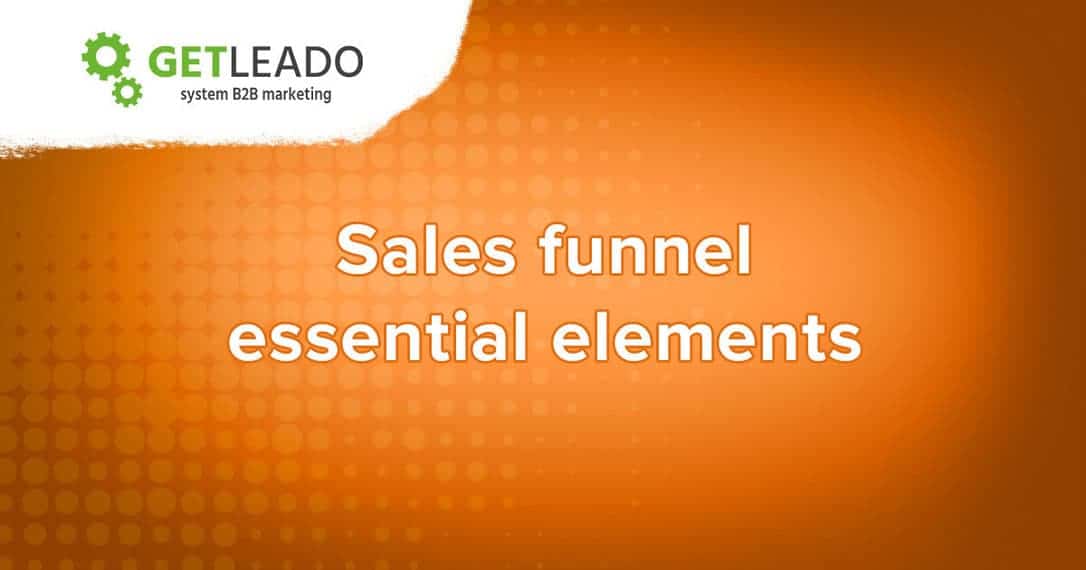
Marketing qualification
The lead should appear in our pipeline only when he passes the marketing qualification and becomes MQL (marketing-qualified lead). Marketing qualification means that this lead fits your ideal customer profile: he is from your target industry or location. His revenue is enough to afford your product. His team size is relevant to your product, etc.
Marketing qualification is the first filter that sorts out all leads and protects your organization from low-quality leads. When you know the MQL to SQL (sales-qualified lead) conversion rate and conversion cycle, you can easily predict how many sales-qualified leads you’ll have in a sales funnel at any given period.
While marketing qualification is used in the marketing funnel, I wanted to describe what is the difference between marketing and sales qualification.
Sales qualification
We use sales qualification as a filter to transfer MQLs from the marketing funnel to sales. It means that sales-qualified met several criteria agreed upon between marketing and sales:
- Engagement. The lead regularly visits your product or service pages, engage with nurturing content, connects on LI, and downloads BOFU content. You can find an example of the engagement criteria below.
- Account research. The marketing or research team has done account research, knows that your solution is an excellent fit for the lead’s needs, and gained insights on how your product can exactly help. Learn more about account research and its role in the ABM strategy here.
- Profile enrichment. Marketing has defined the buying committee structure and collected standard information such as HQ address, team size, tech stack, ad spending, and revenue.
Once the lead meets these criteria and sales accept him, this lead becomes a sales-qualified lead (SQL) and moves from marketing to the sales funnel.
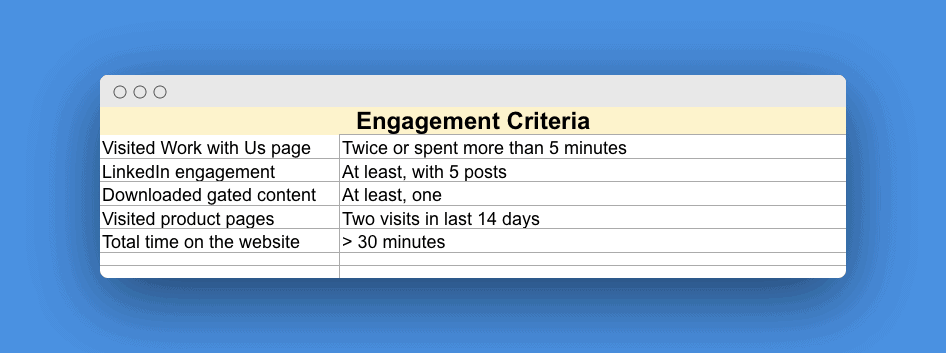
Micro stages
Micro stages are the actions that clients usually take between the first contact with your company and the closed deal. I deliberately wrote clients, not leads. We should analyze only successfully closed deals to figure out these actions.
Here’s an example.
- A prospect visited our website, downloaded the guide, and is marketing qualified.
- Then, after five days, the lead asked for a consultation.
- After two weeks, he asked us to send the product specification.
- A week later, he asked for case studies.
- Two weeks later, the lead initiated a discovery call.
Each of these actions is the so-called micro stage.
Avoiding or skipping one of these micro stages (something sales and marketing teams regularly do) can drastically decrease the number of sales-qualified leads and increase the sales cycle length.
Micro stages help you to understand the buying process and influence it instead of taking a passive waiting position or sending annoying follow-ups like “How are the things on your side?”.
I’ll give you more details about micro stages later in this guide.
Sales funnel velocity
Sales funnel velocity is a trajectory of your revenue based on your sales funnel stats as:
- # of sales-qualified leads
- Deal close rate
- Sales cycle
- Average deal value
Sales funnel velocity shows the healthiness of the sales funnel, helps to set up an objective revenue quota for sales, and predicts future revenue.
I’ll cover sales funnel velocity and every metric in the detail later in this guide.
B2B Sales funnel stages
Prospecting
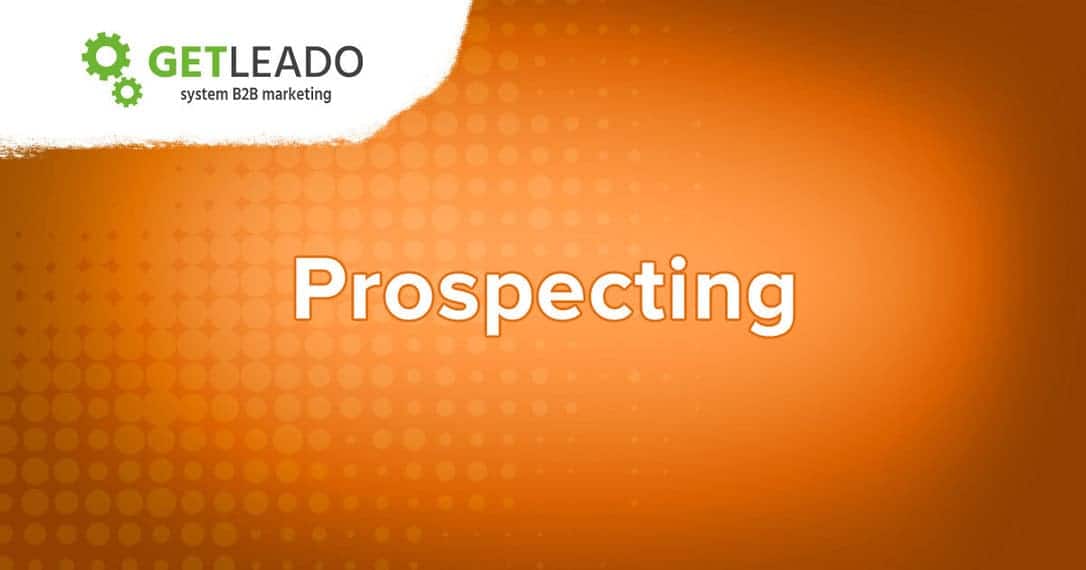
The first sales funnel stage is prospecting. As I mentioned earlier, leads appear at this stage once they are sales-qualified.
During prospecting, you have three core goals:
- connect with the buying committee and warm them up
- build a relationship and learn more about their goals, challenges, and needs
- outreach with your solution and generate discovery/demo calls
Connect with the buying committee and warm them up
If you ask a sales team what they’d love help with before reaching out to the new account, in most cases, you’ll hear:
I want them to be aware of our company and what we are doing.
Depending on your budget, you can warm up your target leads with ads or leverage my favorite LinkedIn inbound marketing framework. Leveraging this framework, you’ll get the views from target accounts much easier, and generate more triggers for connection requests and sales conversations.
Learn more about warming up the buying committee and the LinkedIn inbound marketing framework here.
Building a relationship and gaining insights about lead’s goals and needs
Besides the account research done by your marketing or research team, it is mandatory to get insights into the goals and needs of your prospects. If you have never talked to any of the buying committee members and then suddenly decide to reach out with a question:
What are you and your company working on right now? What are your goals and needs?
You’ll rarely get a reply. Building a relationship takes time.
One of the best examples of how to build a meaningful relationship with clients I learned from James Carbary, CEO at Sweetfishmedia.
James leverages his podcast, The B2B Growth Show, to get meetings with decision-makers from target accounts. Before the show, he warms up them, asks some neutral questions like: “What is your favorite business book?” and tells the agenda. During the interview, they talk about the topic their guest is most interested in.
The most exciting part begins after the official recording part is over.
James asks about the guest’s company goals and needs and introduces his services. After the show, he follow-ups with the link to the episode, distributes it and promotes the guest’s company, sends a small gift (e.g., a book from Amazon), and reminds him about his services + asks about referrals.
This process helps him to personalize his pitch according to the needs and goals of his leads. As well, he consistently generates new clients and referrals.
Outreach with your solution and generate discovery/demo calls.
By default, B2B companies try to reach out to the decision-makers. It totally makes sense if you are targeting small businesses. When you prospect the mid-size or enterprise companies, you need to engage the entire buying committee.
According to HBR, the number of people who influence the purchasing decision grew to 7 people in companies with team sizes from 100 to 500 employees.
When you reach out to C+ people from mid-size or enterprise companies, you’ll rarely get a direct response. There are two standard scenarios:
1. They ignore you, regardless of how creative your outreach was.
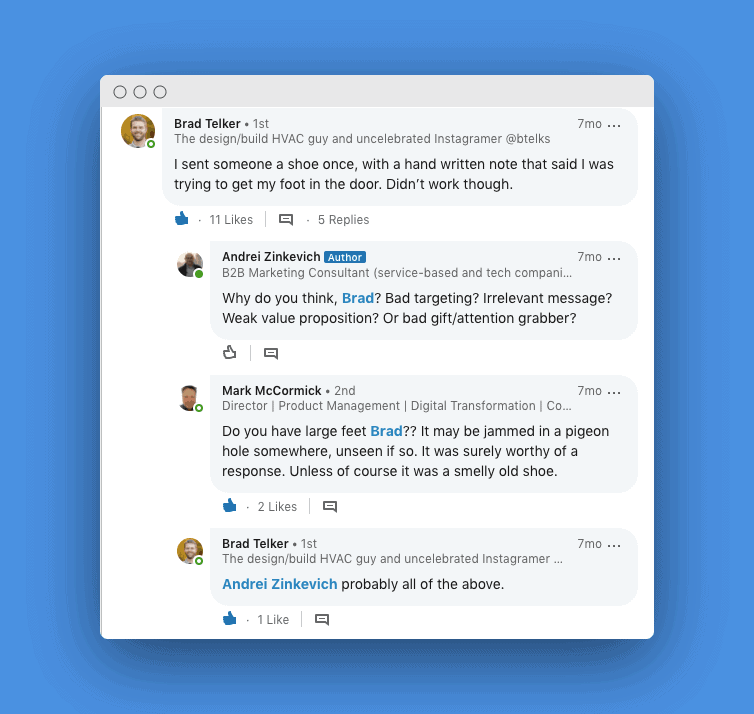
2. They transfer your offer to mid-managers.
Only one thing you should keep in mind – mid-managers don’t like vendors who are jumping over their heads :).
I’ve figured out that once you engage with lower-grade employees who are not decision-makers but might be interested in your product, generate much more quality opportunities. When you start building a relationship with Champions, not only you’ll get precise insights about the goals and needs of your target account, you’ll get a loyal influencer who will help to push your deal.
Last year I ran a campaign for a client selling niche-based software development.
While all the competitors were prospecting CTOs and CEOs, we focused on HRs. It was controversial cause there is a common myth that HRs are in charge of hiring the internal team only. After the in-depth interviews, we realized that it is tough to quickly ramp up the team with a necessary skillset in a narrow niche.
We reached out to the HRs with the physical parcel, including Superwoman (all HRs were women) and Tylenol, proposals, and case studies. In the proposal, we mentioned that HRs are always on fire, and they need to master Superwoman’s skill to maintain all the requests. We knew that their dev team was working on a specific product that required a rare skillset we had.
I used Tylenol just for fun.
If they were not interested in our proposal, they could use it when having a terrible headache with finding a necessary hiring talent. Before the outreach, we ran warming-up IP-based advertising, so they had a clue of who we are.
As a result, from 30 accounts in the campaign, we got two meetings with the decision-makers initiated by HRs.
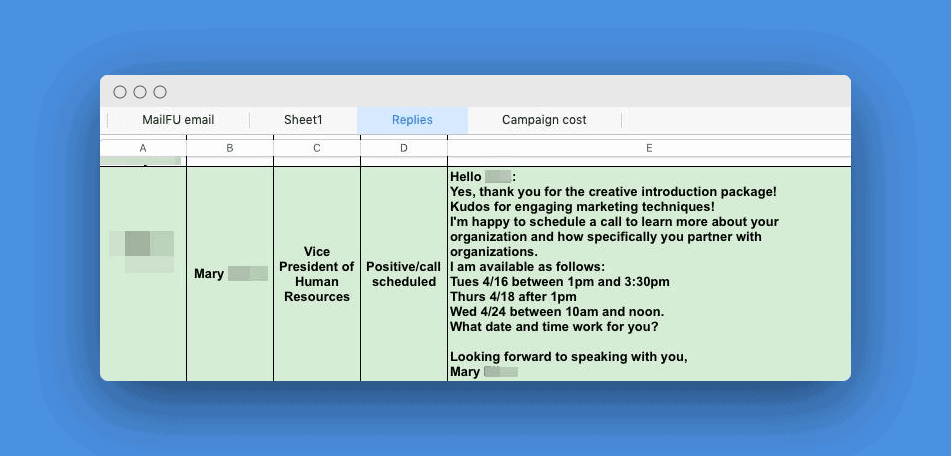
Learn more about the typical B2B buying committee structure, how to identify buying committee members in the ideal customer profile guide.
Discovery call
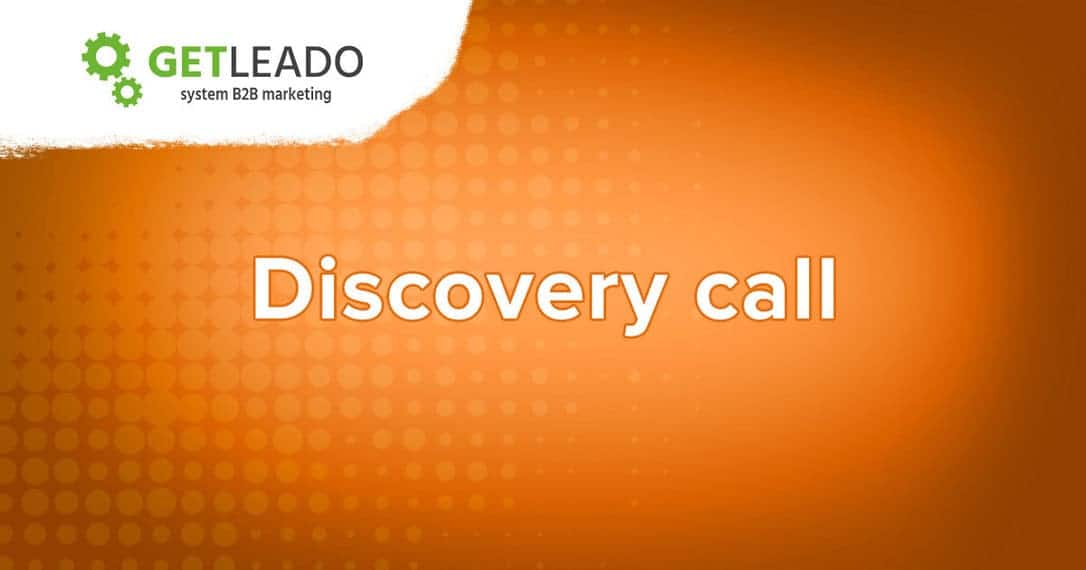
The next stage is discovery or demo calls.
During discovery calls, you have three goals:
- specify the goals, needs, and challenges of your lead
- demonstrate the value of your solution
- sell or pre-sell your product
Specify the goals, needs, and challenges of your lead
The core mistake I see salespeople make is when they start talking about their portfolio or product features instead of specifying goals, needs, and challenges.
People buy products not because they love to click on the buttons. People buy services not because they want “to run digital marketing campaigns.” People buy solutions. Period.
As I’m not involved in sales so much nowadays (I started my career as a sales rep and worked in sales for five years), to complete this paragraph, I decided to talk with a good friend of mine, Juraj Zamborsky. Juraj worked as an SDR at Kontentino, ran 500+ demo calls, and grew the company’s revenue almost from scratch to $25k per month with successful demo calls.
From our chat you’ll learn:
- Triggers that show it’s the right time to suggest lead to schedule a product demo
- The process behind killer sales calls
- What are the right questions to ask during a discovery call to move the lead closer to accepting the deal?
- How to finish the product demo to close most of your calls successfully
- How to close “I need time to think” leads
Demonstrate the value of your solution
To demonstrate the value of the product, SDRs should try to measure the tangible outcomes even if it’s tough to do. The best way to do it is regularly asking your lead a question:
If we were able to provide a solution to the challenge/need you mentioned, what kind of impact will it have for your company?
You can ask about savings, increase in MRR or ARR, churn decrease, or revenue growth. Here are standard questions I ask my clients:
- What will these results mean for your company?
- What will be the extent of improvement?
- How will these results affect the bottom line?
- What are the annualized savings?
- What would be the extent of the improvement?
- What is the scope of impact?
- What if this fails?
- How important is this to your overall responsibilities?
This process is called value selling.
As with the previous point, I decided to talk to a value selling expert, Chad Sanderson, the Managing Partner at Value Prime Solutions. Combining Chad’s knowledge with my own experience, I wrote a detailed article on how to leverage value selling.
You can listen to our chat with Chad and learn more about value selling here.
Sell or pre-sell your product.
The last goal is to sell or pre-sell your product, depending on the sales process you have. While it sounds obvious, lots of SDRs suck at switching discovery calls from discovery to sales. If you don’t get an explicit confirmation of interest in your product, if you don’t give a clear call to action and agree with the lead on the next steps, chances that you’ll close the deal are minimal.
Juraj suggests agreeing on the exact date and time for the next call, create an event in the calendar and ask your contact to confirm it.
After the call, Juraj makes a follow-up with notes from the request and mentions the points the lead liked and asks if it makes sense to proceed to the next step.
Warning signs
If you hear that lead says that he is not sure your product is the right fit, ask for references, rates, it means that they didn’t feel the value of the product.
Try to reframe this question and move the conversation from the details to the solution to the lead’s challenges.
Buying committee nurturing (lead evaluation process)
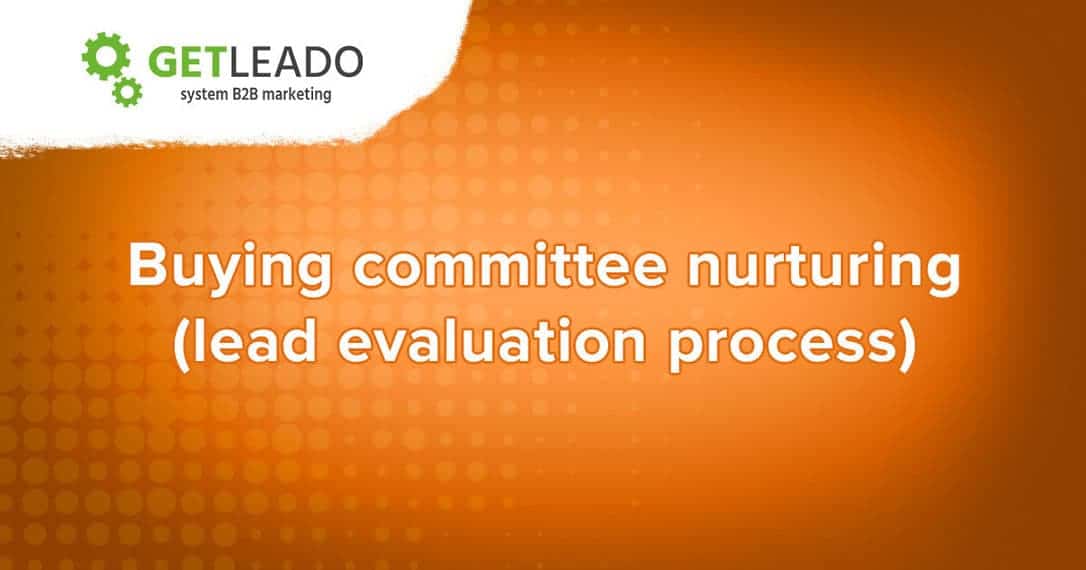
The buying committee nurturing is the “unofficial” sales funnel stage where I usually see the most significant drop-off. Traditionally, after the discovery call, sales reps move the deal to “Pitched,” and follow-up leads with a question:
“How are the things on your side? Any feedback for me?”.
Here is the truth about the B2B buying process (or customer journey).
After the discovery call, they might do additional research, visit review platforms as Capterra or Clutch, introduce your solution to their boss and team.
During this process, they get dozens of questions like:
- “Is it the best product/vendor in this category? How is it different from alternatives?”
- “How can you prove it? Do you have comparison reports or case studies?”
- “What are our benefits/ROI/savings?”
and many more.
So, instead of sending annoying and useless follow-ups, your goal is to armor your Champions with necessary arguments and content to overcome all possible concerns.
How can you do it?
Stay tuned, and I’ll describe it in a second.
Sales funnel micro stages
The best way to understand the in-house consideration process of your target accounts is to run in-depth interviews with your key customers. I’ve described the entire process here.
Once several interviews are done, you’ll see the patterns and will be able to define the standard in-house buying process.
Here is an example.
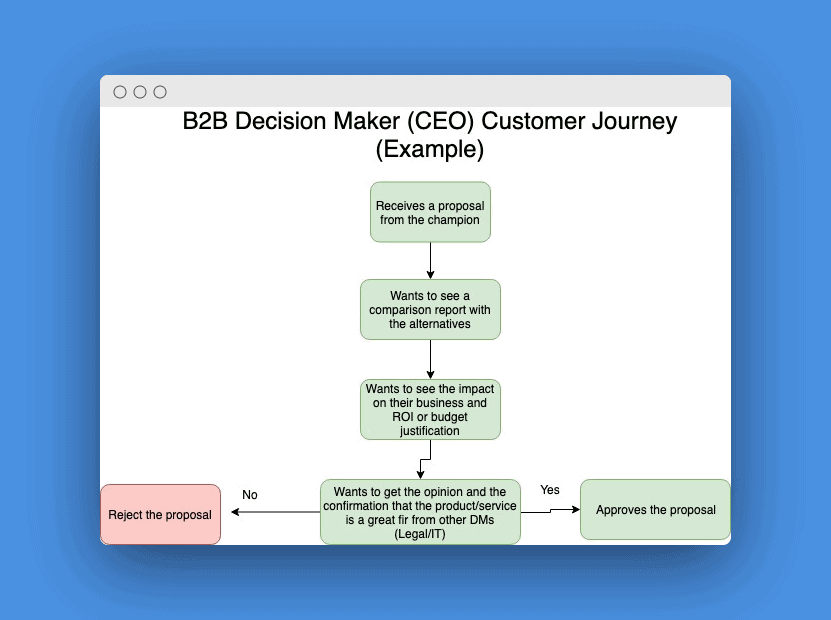
- Five days after the discovery call, the lead asks for a comparison report with other vendors/products.
- After receiving a comparison report from you, seven days later, the lead asks for case studies that are relevant to his business.
- A week then, he asks if you can help with proving the ROI of your service or product.
- Two weeks later, the lead initiates a meeting with a colleague from another department (e.g., with the head of sales) or his boss.
Our goal is to move the lead as quickly as possible through these micro stages and to influence the in-house buying process. There is no silver bullet, but here are some tips that might help you.
1. Create these micro stages in your CRM
Once you’ll do it, you’ll get a clear overview of leaks in your sales process, and understand how to shorten the sales cycle and accelerate sales.
2. Prepare all the content that might help you to accelerate sales.
Instead of waiting when the lead will ask you to send a case study or to prove the ROI, you can prepare all this content in advance. You won’t waste priceless time and lose the “AHA moment’.
Analyze the sales process and the most common requests your customers do when negotiating with you.
Think about what content can help to overcome their objections (e.g., ROI calculator or list of testimonials).
3. Create personalized content hubs to track how your leads engage with your content.
Content hubs will help you to identify hidden buying committee members, be sure that the buying committee members saw your content, and do timely and precise follow-up based on content engagement.
My go-to software for content tracking and creating content hubs is Docsend. Here is an example of analytics you can get inside Docsend.

What is essential when nurturing the buying committee?
Always think about other buying committee members.
- What reasons to block your deal they might have?
- What are their personal goals?
- What are their department goals?
- How does your offer help them to achieve these goals?
- What can motivate them to accept your offer?
With one of my clients (enterprise fintech), we knew that before buying the software, their clients chatted with external auditors. So we created a document for external auditors to demonstrate the value they’ll get from our product.
Here is a part of this document.
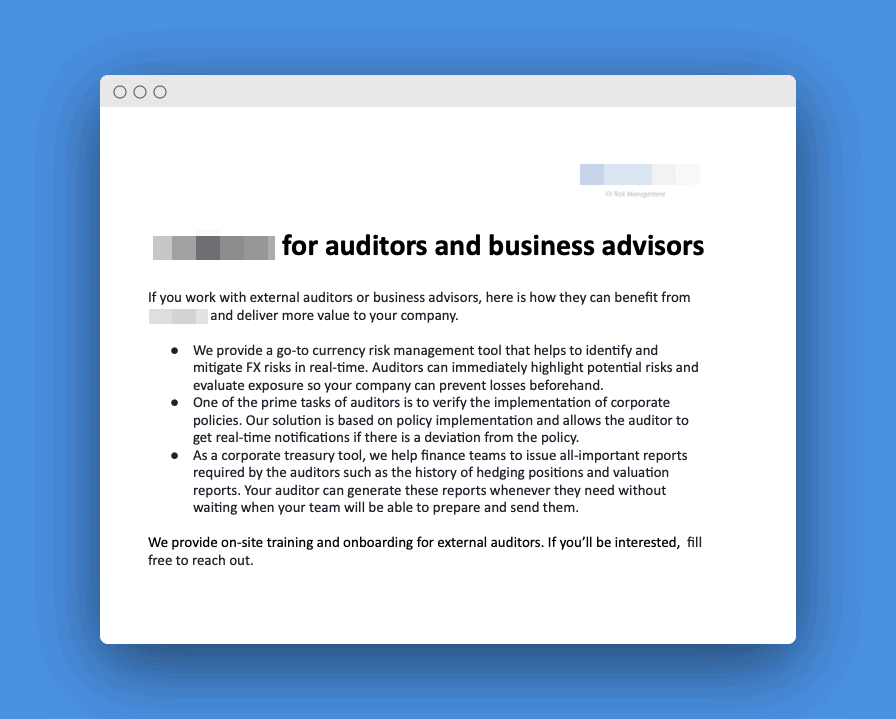
Warning signs
Usually, SDRs use the “Spray And Pray” approach at this stage. They send a proposal and wait for Yes/No without understanding what influenced that decision.
If you leverage my advice and start creating content hubs, you’ll be able to track what’s going on with your content.
If you won’t see any engagement in the lead’s content hub in the next couple of days, it means that the lead is not really interested (your discovery call didn’t convert), or he was swamped.
RFP (request for proposal)

If your lead has successfully passed all the micro stages, he will ask for a proposal. One of the biggest mistakes I see at this stage is sending a generic “one size fits all” proposal.
One of my clients (a software development company) sent their leads just a list of developers and their hourly rates. In 9/10 cases, their leads started to negotiate the rates, and my clients almost always decreased them to close the deal.
When sending a proposal, you need to sell the value and outcomes, not the rates and prices. Always keep in mind the value selling approach.
Here are several tips to improve your proposal.
1. Use software instead of sending proposals in PDF or Excel.
Here are several benefits of using software instead of sending proposals in PDF or Excel.
1. Tracking the engagement
With the software, you’ll be immediately notified when the lead opened your proposal. You can see how much time the lead spent on every slide/page and will be able to follow up accordingly.
2. Making a great impression
Of course, you can ask the designer to design all the proposals, but leveraging beautiful templates simplify time and costs.
3. Digital signature
Your proposals can be accepted and signed in one click instead of printing, signing, scanning, and sending you’re originals.
4. Automation
You can set up automated follow-ups if the lead didn’t open or didn’t accept your proposal and sync the follow-ups with your CRM.
My go-to software for sending proposals is Nusii.
2. Mention challenges, solutions, and outcomes
The same as with the discovery call summary, you need to highlight the challenges, solutions, and outcomes in your proposal.
I usually start the proposal with the challenges to generate a feeling “that he understands our needs.” Here is an example.
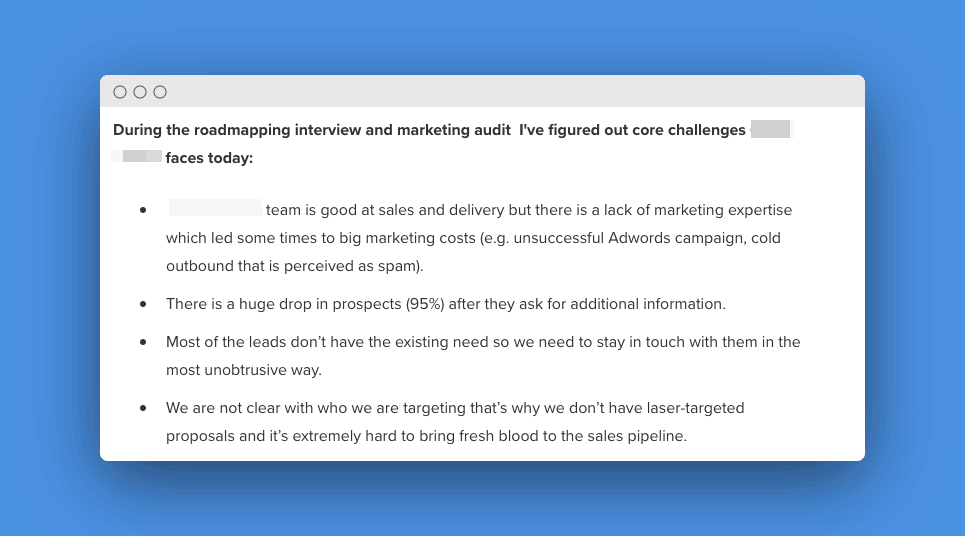
The next step is providing a solution to these challenges.
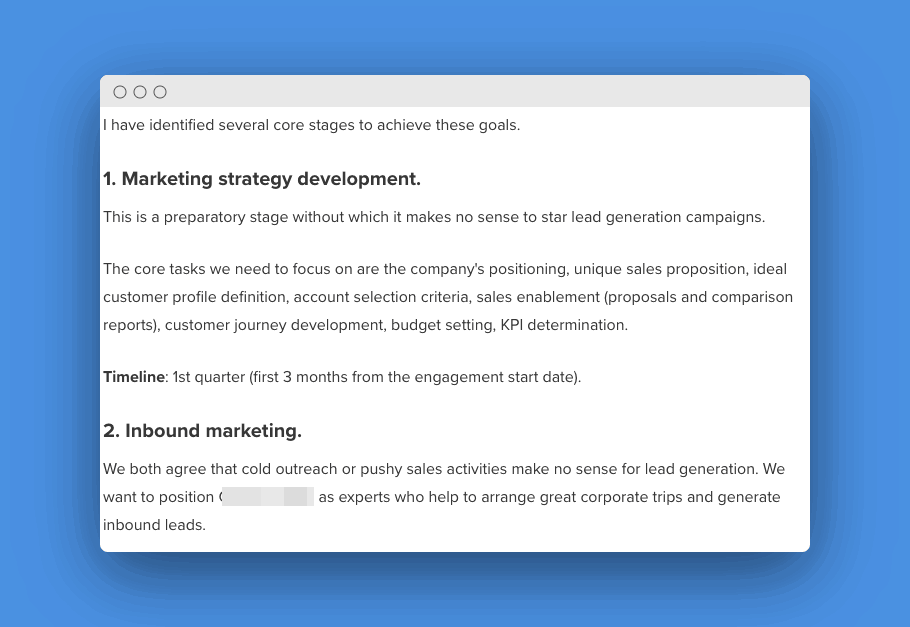
And the last step is proving the outcomes based on the data you have.
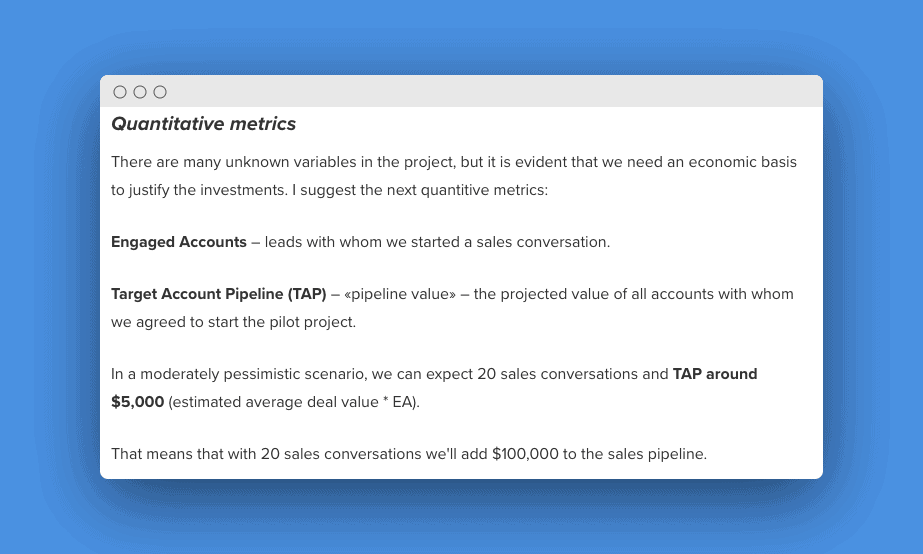
3. Add a social proof
There is one thing that can’t be too much – social proof. Add testimonials of customers from the same industries, add their logos, and add awards or certificates.
I leverage reference letters in my proposals.
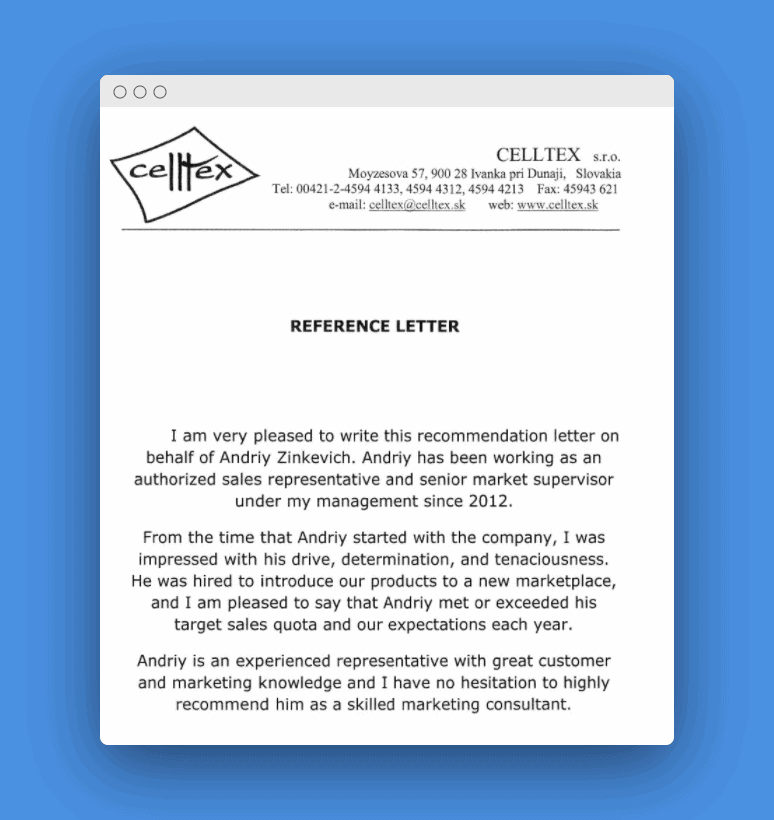
4. Provide as many details as possible
The same as with social proof, there can’t be too many details. I provide my clients with a detailed marketing plan, team structure, resources, tech stack, budget, collaboration process, etc.
Even if my Champion has heard all the details many times, keep in mind that other buying committee members might read your proposal. So questions about the details might appear. Your goal is to avoid it.
5. Provide pricing options
The last recommendation is to provide several pricing options. While SaaS companies successfully leverage this approach, I rarely see it in a service business.
The easiest way to start with pricing options is to add and cut 20% of the value to your standard offer.
How would your service look like if you’d start doing more for your client?
How would your service look like if you’d start doing less for your client but still helping him to solve challenges?
If you want to dive deeply into the topic, here is a great guide written by Neville Medhora.
Warning signs
If at this stage, you receive new concerns or your leads negotiate pricing, it means they don’t see the value.
Analyze your proposal, and see how you can improve it, leveraging the steps above. And suggest your lead jump into a call where your goal would be reframing pricing negotiation and sharing the value and outcomes again.
Legal

The last sales funnel stage is legal.
While it seems that sales and marketing aren’t involved in this stage, it’s not true, especially if you operate in the tech industry.
Quite often, you can hear concerns from the client’s IT team about the security of your solution/services and integration with their tech environment. Think beforehand about how you can address these concerns and armor your Champion with indispensable guides.
All other stuff, let’s leave for legal experts.
Sales funnel metrics

Now le’s talk about the five essential B2B sales funnel metrics I suggest you track regularly.
Sales funnel velocity
The first and most important metric is sales pipeline velocity.
Sales funnel velocity shows us the healthiness of your sales funnel and yearly revenue trajectory. Here is a formula to calculate sales funnel velocity:
# of SQLs x Deal Close Rate x Av. Deal Value / (Sales Cycle / 360).
I’m going to provide you with a detailed answer to how each of these metrics influences sales funnel velocity and revenue in the next couple of paragraphs.
Sales cycle
A sales cycle is the timeframe from sales qualification to a successfully closed deal. The sales cycle influences your sales pipeline velocity helps to predict revenue, and gives a clear understanding of the length of the bottom-of-the-funnel lead nurturing programs.
To give you more clarity, let’s look at the screenshot below. By shortening the sales cycle from 72 to 64 days, we can expect + $230k in the next period.
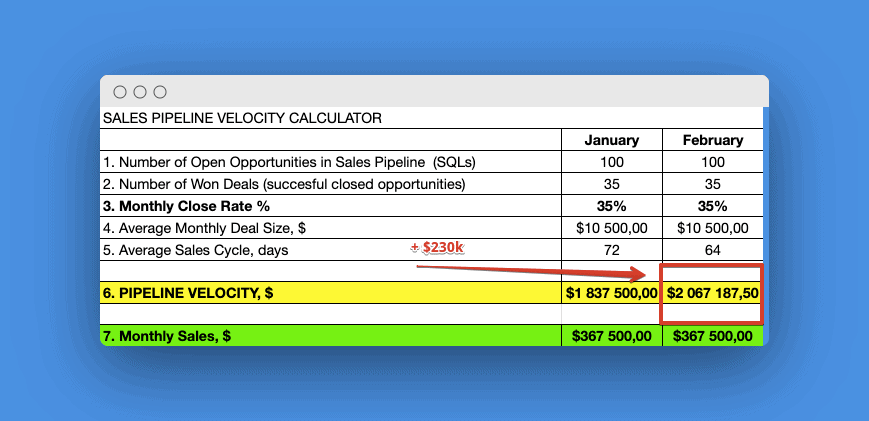
As well, we understand that the minimal length of our BOFU leads nurturing program and cadence of touches should be at least 10-11 weeks.
I suggest tracking also the time leads spend on each of the micro stages. The regular analysis will provide you insights into what stage slows the deal, so you’ll be able to improve it.
# of sales-qualified leads
Now let’s see how our revenue will change if we’ll generate 10 more sales-qualified leads without changing other metrics. A quick calculation shows + $236k in yearly revenue.
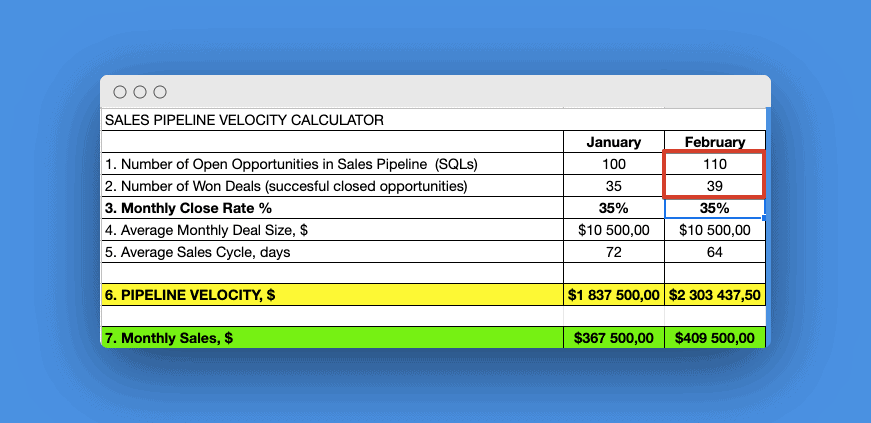
Average Deal Value
Even a small increase in average deal value can drastically increase revenue. Looking back to our example, if we increase the average deal value by $500, we’ll generate an additional $110k in yearly revenue.

How can you increase an average deal value?
There are three ways:
- Implement value selling
- Provide pricing options
- Develop lead nurturing programs
Deal Close Rate
Deal close rate is a ratio of successfully closed deals compared to generated sales-qualified leads (opportunities) in the same period.
Let’s look at our example.
In January, we generated 100 SQLs and closed 35 deals. Our deal close rate is 35%. In February, we increased the deal close rate by 3% and generated +$185k in yearly revenue.
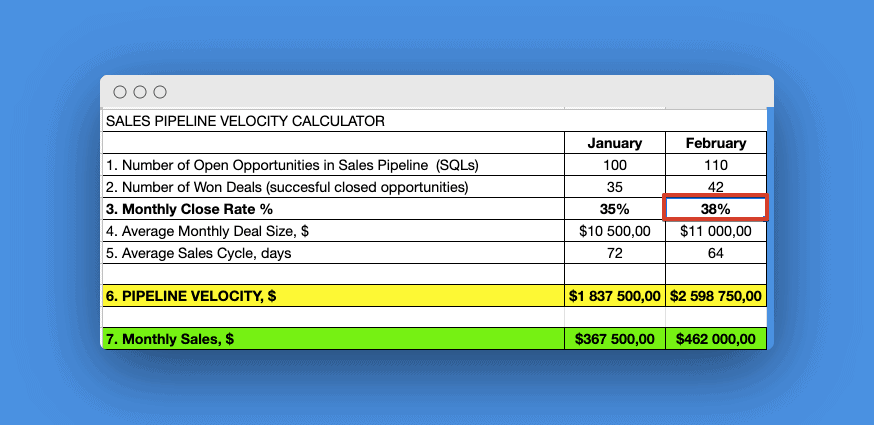
Now let’s talk a little bit about software for sales funnel management.
B2B sales funnel software

There are hundreds of SaaS products you can use for developing and managing your sales funnel. I’ll describe my favorite: Active Campaign.
Active Campaign has CRM and sales automation, marketing automation, email marketing features, and dozens of integrations. It is pure gold for pipeline management.
What I dislike in most CRM software is that they either don’t have web forms as a feature or web forms have a basic functionality: they don’t redirect the user to the custom URL after form submission or don’t have custom fields. So you need to find another software to create web forms and integrate them with CRM via Zapier.
With Active Campaign, you can build as many web forms as you need, set up custom redirects after form submission, add tags (I forgot to tell you that Active Campaign is a tag-based system) and add them to specific lead-nurturing campaigns.
Best of all, you can create pop-ups, floating bars, and floating boxes directly in Active Campaign.
As for custom fields, you can choose simple text field radio buttons, hidden fields, drop-down menus, multi-selection lists, and dates. This makes Active Campaign web forms perfect for marketing and sales qualification.
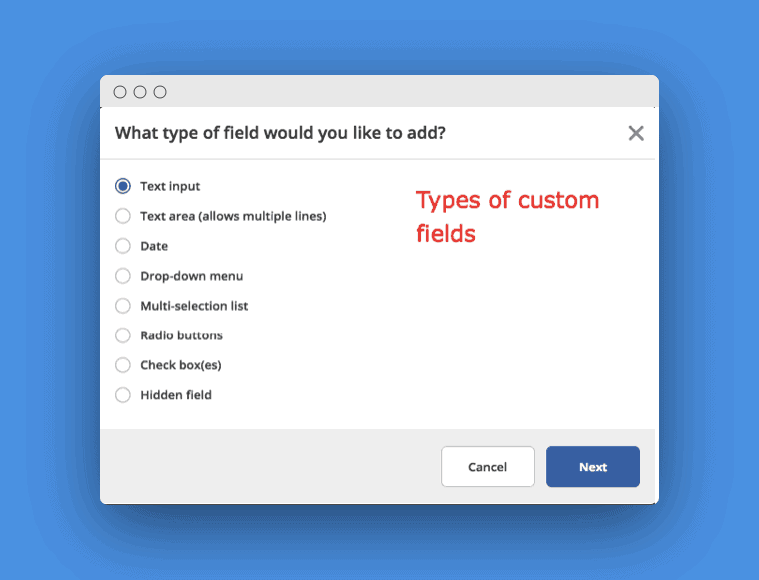
All the collected data will be stored in the contact’s profile.
Sales pipeline management
Pipeline management in Active Campaign is similar to any modern CRM.
It has a drag-and-drop feature and a live desk with all opportunities. You can upload or download your list of contacts.
The feature I like most is a built-in sales automation process (which some CRM make available only in enterprise packages)m which tracks the lead’s behavior (like website visits, content downloaded, or links shared).
You can easily leverage it for lead nurturing and lead scoring.
You can set up an automated process when the lead should be driven to the next micro stage in your sales funnel and add tasks to the sales team based on the lead’s activity.
This awesome and valuable feature helps you minimize the human factor in the early stages of the sales process.
Lead nurturing
As I mentioned earlier, Active Campaign simplifies the lead nurturing process with features as email marketing, website messages, and SMS.
Also, Active Campaign is a tag-based system so you can add or remove tags for every lead action.
This helps you to create hyper-targeted segments and drastically improve the efficiency of the lead nurturing process.
Lead scoring
Active Campaign has a straightforward and easy method to apply lead scoring.
You just add a score based on behavior or the lead’s characteristics in your automation. Active Campaign immediately displays it in the lead’s profile. All the data updates in real-time, so your sales team will immediately be notified of every sales-ready lead.
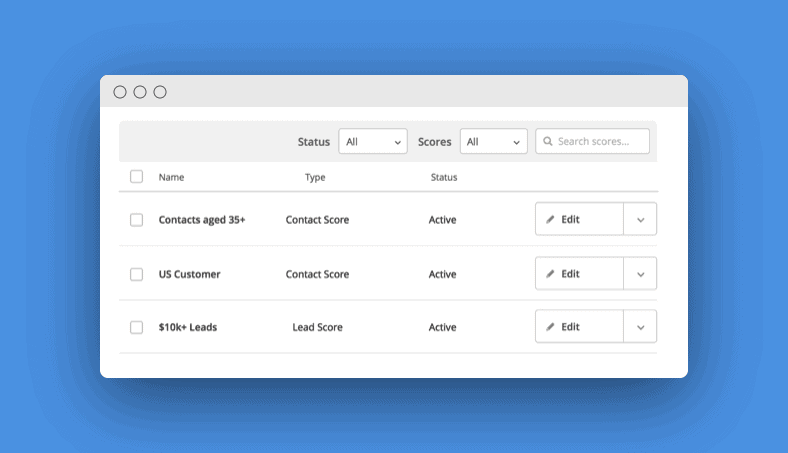
How to create a B2B sales funnel
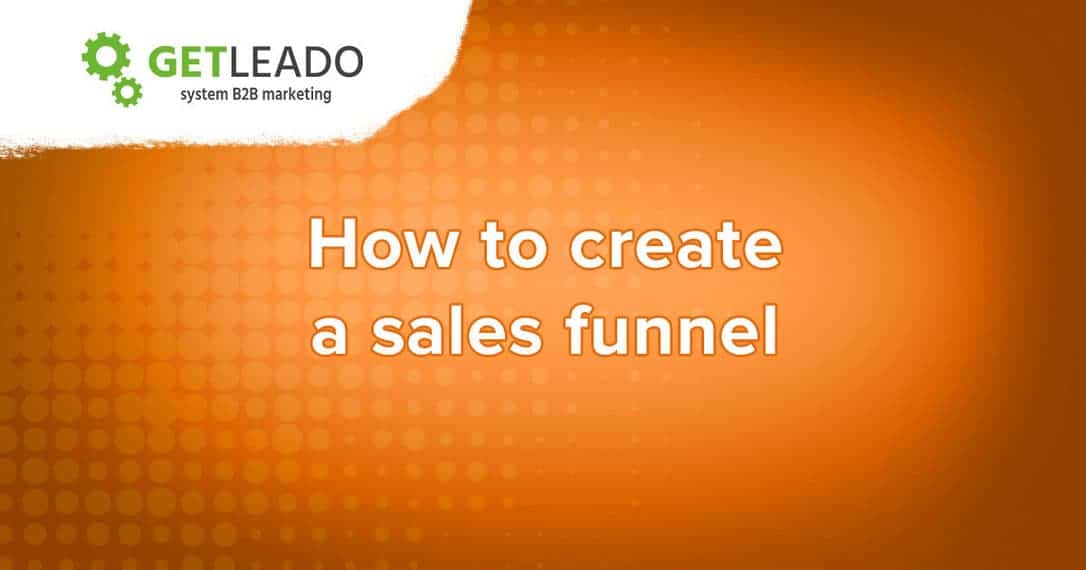
Now let me wrap up all the knowledge and share with you a step-by-step framework on how to create a B2B sales funnel.
1. Define your core sales funnel stages
The first step is defining and aligning sales funnel stages between marketing and sales teams. Traditionally, you have five stages:
- Prospecting
- Discovery Call
- Buying Committee Nurturing
- RFP
- Legal
But you need to define your stages. The more specific the sales funnel stages will be, the better analytics and insights on how to improve your sales process you’ll have.
At Getleado, my sales funnel stages are:
- Sales Qualification (Intake Questionnaire)
- Discovery call
- Marketing Audit And Roadmapping Offer
- Buying Committee Nurturing
- Roadmapping Delivery
- Long-Term Engagement RFP
- Legal
2. Define the essential micro stages
The next step is identifying your micro stages. I highly recommend analyzing the buying process of your key customers, talk to them, and identify patterns. Once you identify these micro stages, you’ll be able to win more opportunities.
Applying this process, I was able to shorten Getleado’s sales cycle by 20 days.
How?
I’ve figured out that my customers usually ask me to send examples of marketing audits, roadmapping delivery, and examples of campaigns, we’ll be working on in the future (big picture), after the discovery call.
So, before sending a marketing audit proposal, I started to create personalized content hubs with examples of delivery and campaigns and included the link to the content hub.
3. Choose software for managing the sales process and analyze the sales funnel
In this guide, I’ve already shared with you my favorite software – Active Campaign. But if you are looking for alternatives, I suggest Salesflare.
Salesflare has in-built account enrichment and automation features and is a perfect fit for companies that don’t have advanced lead nurturing programs and don’t do lots of TOFU (top-of-the-funnel) and MOFU (middle-of-the-funnel) campaigns
One feature that outstands Salesflare from others is the MRR feature. If you are from SaaS, Salesflare will probably, be the best CRM software for your company.
4. Set up analytics
Besides standard sales reports, I suggest you track the sales funnel velocity and all the metrics that impact it:
- # of sales-qualified leads
- Average deal value
- Sales cycle
- Deal close rate
It will help you to track the healthiness of your sales funnel, see the yearly revenue trajectory and control the impact of every metric on revenue.
If your CRM doesn’t have a sales pipeline velocity report, you can download my template below, including Getleado’s sales funnel.
Next Steps (W/Free B2B Sales Funnel Template And Sales Funnel Velocity Calculator)
Following my step-by-step framework, you can improve your sales process, create a high-conversion b2b sales funnel, accelerate your sales, increase average deal value, close more deals, and, as a result, grow revenue.
The best part?
You’ll have full control of your sales process, will be able to influence the decision-making process of your leads, and have a clear overview of what parts of your sales funnel need improvement.
If you want to get a free copy of our sales funnel and sales pipeline velocity calculator I use for tracking the healthiness of the sales funnel, click here.
Learn more about B2B sales funnels
Here are some more steps for you if you want to learn more, have any questions, or need any help:
- If you want to understand the entire full-funnel marketing process, join our Full-Funnel Academy.
- If you want to refine your sales process or develop a customer-centric sales funnel from scratch, book a call with us here
- Join our Full-Funnel B2B marketing community
Then before you go.
Let me know in the comments below right now:
What’s the ONE thing you’re going to start optimizing your sales funnel?
- Defining micro stages
- Tracking the healthiness of the sales funnel with a sales pipeline velocity calculator
- Developing buying committee nurturing programs
Or something else?




